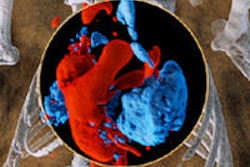Wednesday, November 28 | 11:10 a.m.-11:20 a.m. | SSK11-05 | Room N230
Virtual high-keV images of spine hardware at dual-energy CT (DECT) show less artifact and are easier to read than conventional CT images, according to a research team from the University of Michigan."Since hardware produces artifact on CT, it is often not possible to evaluate if there is loosening," Dr. Ashok Srinivasan told AuntMinnie.com. "We felt that the monochromatic images generated using dual-energy CT would be of benefit in this regard due to reduced beam-hardening artifact."
The study compared image quality of postfusion spine CT scans on two acquisition protocols from a 64-detector-row dual-energy CT scanner (Discovery CT750 HD with gemstone spectral imaging, GE Healthcare). One set was created using the monochromatic image feature at the standard 70 keV, while another set was created at higher virtual keVs (100 to 140).
The researchers analyzed each transpedicular screw on a four-point scale for artifacts, with 4 representing optimal image quality. In analyses of 89 screws, the mean higher-energy score (3.26) was significantly higher than the standard score (2.25), the authors found.
"Our results imply that dual-energy CT can be helpful in more accurate assessment of the interface between hardware and adjacent bone," Srinivasan said.




















